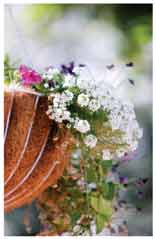Your Garden in Summer - Healthy Life Essex
Home » Articles » Outdoor Life » Gardening in Essex » Your Garden in Summer
Your Garden in Summer

June
June is a wonderful time in the garden. If established, it will be a wonderful mass of young foliage and flowers full of colour and perfume. What a pleasure it is to be outside, even if there are lots of chores to be done.
MULCHING
Mulches can be applied at any time of the year but if it has not already been done, or needs topping up, don’t delay. Chipped bark is excellent and really sets off the plants, but do make sure the ground is damp before putting it on. With the threat of our summers becoming dryer each year it really is a must to help prevent water loss.
WEEDING
Keep the weeds under control this month before they really take hold. Hoe on hot days when the weeds will die quickly, and dig up perennial weeds before they become established.
 HANGING BASKETS
HANGING BASKETS
There are lots of baskets to choose from, but the best are probably the open mesh type which can be planted all round. Use a good potting compost and a controlled-release fertiliser. There is a huge selection of plants available for hanging baskets. Cram as many in as you can for a superb display, but do remember to keep them watered well (using your water butt or grey water). Many vegetables are also superb for hanging baskets, a great idea if you have limited space. For tasty cherry tomatoes try ‘Tumbler’, an ideal trailing basket variety. For colour contrast you could also grow ‘Yellow Tumbling Tom’. And why not experiment with ornamental gourds, lettuce and delicious strawberries.
July
The brightest of flowers are abundant in July, with the hardy annuals in the borders really making a show. Summer evening can be glorious, especially if you have a good selection of plants with scented flowers. These also attract insects and help keep pests at bay.
TRIMMING HEDGES
Conifer hedges can now be trimmed. Avoid cutting hard back into old brown wood as they rarely re-grow. Other fast growing evergreen hedges can also be trimmed if they are straggly.
WATERING
Although we may have long dry spells, we should ensure water is used economically. Install as many water butts as you can to collect rainwater, and use ‘grey water’ from baths and showers when appropriate. If collected water starts to smell put about 8oz barbeque charcoal in the bottom of the barrel. If you do water with a hosepipe, do so either early in the morning or the evening to avoid evaporation. And a thorough soaking is far more effective than frequent drizzles
 BULBS AND TUBERS
BULBS AND TUBERS
Keep the garden colourful in September and October by planting autumn flowering bulbs now.
CONTAINER PLANTS
Containers and hanging baskets will dry out very quickly so keep them well watered, usually once a day and sometimes more. Deadheading as soon as flowers have died will produce lots more blooms and, unless a slow-release fertiliser has been used, feed with a liquid fertiliser twice a week.
August
With many nectar-rich flowers in August, we can hope to see lots of butterflies. The best butterfly shrubs are hebe, hyssop, lavender, privet and, of course, the aptly named butterfly bush (Buddleia davidii).
ANNUALS
Pull up and compost annuals that have finished flowering. Fill the gaps with other plants such as dahlias.
BULBS
Plant daffodils and narcissi towards the end of the month. As a guide, the planting hole should be three times the depth of the bulb. If the ground is not ready, pot them up deeply now and plant out in spring.
ROSES
Gather and dispose of diseased leaves that have fallen to the ground as the disease spores can over winter in the ground. Burn them if you can.
HERBS
If you would like a regular supply of your favourite fresh herbs throughout winter, pot some up now so they can be moved inside in October. Mint and lemon balm can be dug up from the garden. Parsley is best grown from seed. Young shrubby plants like sage and rosemary are ideal. And, of course, you can also cut and dry your own herbs.
Picture Credits
“Beautiful flowers” © Photographer:Maxfx | Agency: Dreamstime.com

